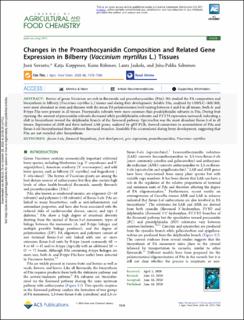| dc.contributor.author | Suvanto, Jussi | |
| dc.contributor.author | Karppinen, Katja | |
| dc.contributor.author | Riihinen, Kaisu | |
| dc.contributor.author | Jaakola, Laura | |
| dc.contributor.author | Salminen, Juha-Pekka | |
| dc.date.accessioned | 2021-01-22T13:41:10Z | |
| dc.date.available | 2021-01-22T13:41:10Z | |
| dc.date.created | 2020-08-19T14:16:24Z | |
| dc.date.issued | 2020-06-16 | |
| dc.identifier.citation | Journal of Agricultural and Food Chemistry. 2020, 68 (28), 7378-7386. | en_US |
| dc.identifier.issn | 0021-8561 | |
| dc.identifier.uri | https://hdl.handle.net/11250/2724304 | |
| dc.description.abstract | Berries of genus Vaccinium are rich in flavonoids and proanthocyanidins (PAs). We studied the PA composition and biosynthesis in bilberry (Vaccinium myrtillus L.) tissues and during fruit development. Soluble PAs, analyzed by UHPLC–MS/MS, were most abundant in stem and rhizome with the mean PA polymerization level varying between 4 and 6 in all tissues. Both A- and B-type PAs were present in all tissues. Procyanidin subunits were more common than prodelphinidin subunits in PAs. During fruit ripening, the amount of procyanidin subunits decreased while prodelphinidin subunits and F3′5′H expression increased, indicating a shift in biosynthesis toward the delphinidin branch of the flavonoid pathway. Epicatechin was the most abundant flavan-3-ol in all tissues. Expression of ANR and three isolated LAR genes, analyzed by qRT-PCR, showed connection to accumulation of PAs and flavan-3-ols biosynthesized from different flavonoid branches. Insoluble PAs accumulated during berry development, suggesting that PAs are not recycled after biosynthesis. | en_US |
| dc.language.iso | eng | en_US |
| dc.publisher | American Chemical Society | en_US |
| dc.rights | Navngivelse 4.0 Internasjonal | * |
| dc.rights.uri | http://creativecommons.org/licenses/by/4.0/deed.no | * |
| dc.title | Changes in the Proanthocyanidin Composition and Related Gene Expression in Bilberry (Vaccinium myrtillus L.) Tissues | en_US |
| dc.type | Peer reviewed | en_US |
| dc.type | Journal article | en_US |
| dc.description.version | publishedVersion | en_US |
| dc.rights.holder | © 2020 American Chemical Society | en_US |
| dc.source.pagenumber | 7378-7386 | en_US |
| dc.source.volume | 68 | en_US |
| dc.source.journal | Journal of Agricultural and Food Chemistry | en_US |
| dc.source.issue | 28 | en_US |
| dc.identifier.doi | 10.1021/acs.jafc.0c02158 | |
| dc.identifier.cristin | 1824092 | |
| cristin.ispublished | true | |
| cristin.fulltext | original | |
| cristin.qualitycode | 2 | |

